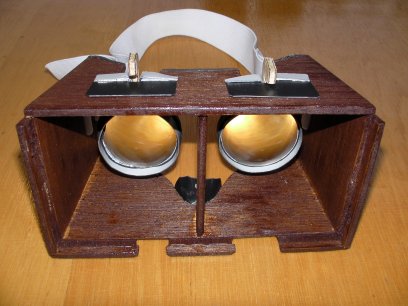




 |
DIY 3D Virtual Reality Goggles | 
 |
 3D television and 3D cinema are becoming wide-spread, but 3D Virtual Reality goggles (or glasses), despite
being a many decades old idea, are just (as of 2013) receiving increased attention.
The few commercial devices available don't sell well, in parts due to price,
but a cheap alternative has emerged: A modern SmartPhone,
two lenses for under 10$ and some cardboard and glue
is all you need to build your own 3D-VR goggles.
There are already various DIY websites, but no single comprehensive one.
This one is neither. It is mainly a list of resources I found useful, as of 2013, and my own experience in building one.
3D television and 3D cinema are becoming wide-spread, but 3D Virtual Reality goggles (or glasses), despite
being a many decades old idea, are just (as of 2013) receiving increased attention.
The few commercial devices available don't sell well, in parts due to price,
but a cheap alternative has emerged: A modern SmartPhone,
two lenses for under 10$ and some cardboard and glue
is all you need to build your own 3D-VR goggles.
There are already various DIY websites, but no single comprehensive one.
This one is neither. It is mainly a list of resources I found useful, as of 2013, and my own experience in building one.










| © 2000 by ... | home | search | science | personal | contact | up | ... Marcus Hutter |